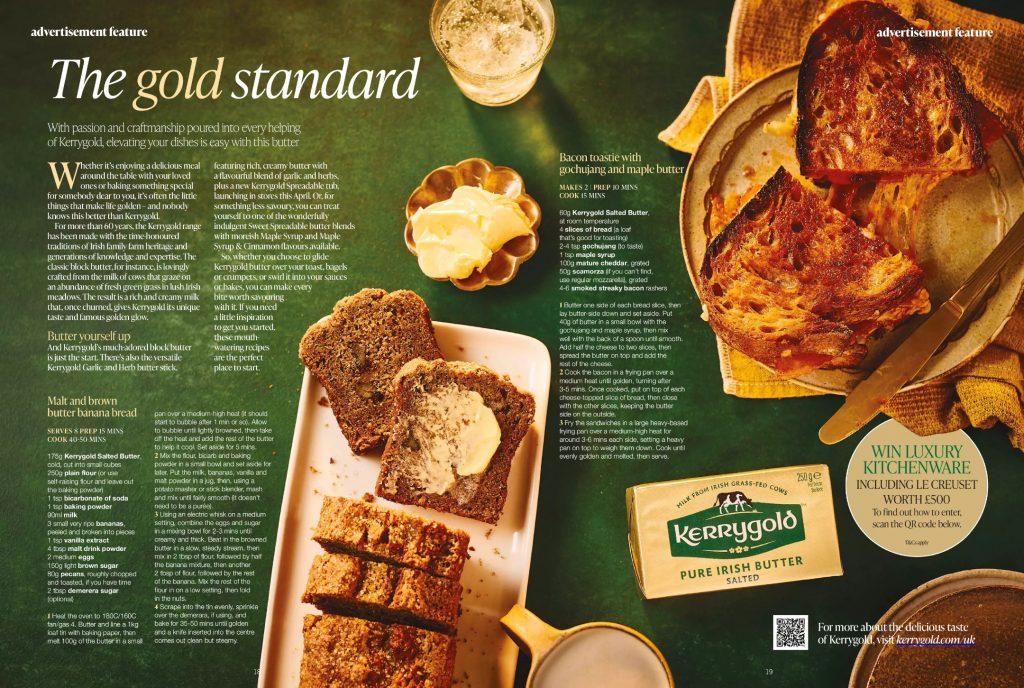Media matters: Why magazine media works for… food
Three media planners and one marketer discuss their magazine media strategies
This article originally appeared in Campaign.

Magazine media in all its multichannel forms is a vital part of the mix when it comes to helping food marketers create brand building campaigns that contextually align with relevant content and capitalise on key food moments in the calendar, according to media planners.
And the UK’s appetite for food and drink content is substantial, with 62% of adults engaging online monthly according to Ipsos iris. This peaks in December with 21m adults visiting trusted editorial brands’ food and drink content across the month, reaching a high of 3.25m on Christmas Eve.
Ruby Hann, broadcast executive at Mediaplus UK, explains that she always highlights the high quality of magazine brands and content to her clients.
“They can trust that their brand will feature alongside editorial produced by industry experts, and that magazines are proud to attach their name to, “ she says.
“We are also often able to get a sneak preview of upcoming issues, which enables us to run our brands alongside the most relevant stories or even collaborate on features.”
Looking at more specialist magazine titles, Hann likes to remind clients that while they might be reaching a smaller audience than if they had used other media channels, they are reaching a more engaged one.
“These [magazine readers] are the people who are so passionate about their hobby – whether that’s food, technology, or film – that they are willing to spend on it,” she explains. Plus, what better time to reach someone than when they’re relaxed and stuck into reading about their favourite things.”
New research from PPA Magnetic, in partnership with Ipsos iris, proves the value of communities who are passionate about food, whether it’s for new recipes, key ingredients, or the latest food trends. Five million adults in the UK are particularly keen on seeking food and drink content online, and 94% of them visit trusted editorial brand websites.
Emily Henderson, senior print and publishing executive at The Specialist Works, adds that while some people might fall into the trap of assuming that print media is a traditional, outdated media source, it is a hugely effective channel because of its scalability, data targeting and tracking abilities.
“Print editions of magazines tend to stay in the home for 7.46 days on average,” she says. “This yields high attention time which is really important in a digital age where dwell time on display and digital ads is extremely low.”
This engagement in editorial content environments is evident online too. PPA Magnetic’s research highlights the importance of relevant, high-quality, brand-safe environments. The most passionate users of trusted editorial brands consume 29% more food and drink-related content, compared to heavy users of social media.
Challenges
Danny Micklethwaite, vice president of marketing at Arla Foods UK, says the UK is currently in a food crisis.
“We urgently need to work together to feed a fast-growing population with more healthy, more natural and more sustainable foods,” he warns. “So, at the very highest level, marketers need to evaluate the role that they are playing to address this situation. If you are not making a positive change then are you doing the right things?”
According to Micklethwaite, Arla is taking responsibility for driving change in terms of the foods it makes and its sustainability efforts across the value chain. “But to inspire consumer action we need our marketing to stand out in an already crowded space.”
Experts also point to constantly changing regulation around High in Fat, Salt, and Sugar (HFSS) products that restrict advertising, as well as ever-changing health guidance, food trends, consumer preferences and political movements that make it tricky for marketers to align with their audiences.
In addition, shifts in consumer habits have led to a rise in e-commerce platforms and online shopping, with brands having to adapt to increased demand for rapid delivery services and platforms that offer groceries online.
Understanding the influence of trusted editorial brands in the purchase funnel is key to adapting to changes in purchase behaviour. Online magazine brands play a key role in the middle of the funnel, where food and drink content inspires and drives consideration. They also help users fill their online baskets – nine in 10 magazine brand users visit a supermarket retailer after reading food and drink content online each month.
Magazine media to the rescue
One way in which brands can navigate HFSS regulations more easily is via magazine media.
“We can utilise multi-media platforms to overcome HFSS challenges through partnerships with magazine publications that incorporate social media, emails and display opportunities,” Henderson notes. “This is an effective way to extend reach and build frequency while navigating HFSS regulations through channels that aren’t heavily restricted.”
Magazine brands are also increasingly important sources of verified information.
Lily Bennett, social and content senior executive at Goodstuff, warns that while social media has allowed people to educate themselves on “healthy” food habits and innovative recipes – from Dubai chocolate to lasagne soup – the medium is also rife with misinformation.
In addition, new food trends appear weekly, which makes it difficult for marketers to keep up.
Bennett highlights that magazine brands can support marketers when it comes to predicting food trends, because publisher brands “garner cultural learnings that can inform what’s next to come”.
“Magazine media is a trusted source and provides marketers with a controlled environment for honest information to be shared, avoiding any misleading information in heavy body text,” she says.
“Additionally, magazine media has adapted and taken on a social media approach as well, where titles typically have strong followings to allow marketers to reach audiences and gather precise results that justify its worth.”
Work that works
In December, Hann worked with Tony’s Chocolonely to run a full-page display ad in the bumper Christmas edition of The Big Issue.
“It was clear to us that Tony’s and The Big Issue were a perfect fit: both brands care deeply about issues of fair labour and sustainability,” she says.
According to Hann, running in The Big Issue allowed the brand to reach readers who are socially engaged and already likely to be aligned with its mission to end exploitation in the cocoa industry.
“Plus, featuring alongside feel-good Christmas content helped to remind readers that a bar of Tony’s makes the perfect holiday gift,” she adds.
“While creative is a key way to ensure campaigns stand out, it is too easy for brands to reuse creative ideas, which in turn can lead to creative fatigue.” Bennett advises agencies and brands to focus on storytelling over selling.
“You can tell a story with mouthwatering visuals, hanging it on seasonal and/or topical relevance,” she says. “Encouraging innovation should be at the heart of everything marketers do. With this in mind, we should avoid overloading creatives with text and focus on the story, with a call to action and compelling visuals.”
How Werther’s Original sweetened up younger crowd with Immediate Media

How can a classic confectionery brand win over a new generation? Immediate Media’s Imagine team put itself to the test by evolving its “A Little Piece of Warmth” campaign for Werthers Original, now in its second year. The strategy? Inject some fresh energy and appeal to a younger audience while still keeping its loyal base happy. The campaign spread across Immediate’s portfolio, including Good Food, Olive, Gardeners’ World, Radio Times, and MadeForMums.
To stir things up, they brought in The Great British Bake Off’s Alice Fevronia. She whipped up six original recipes featuring Werther’s, showcased in both advertorials and video. This move paid off, with social content hitting a 3.3% click-through rate, nearly doubling the usual benchmark. Fevronia also lent her voice to podcast ads.
The “Werther’s Challenge” put the Good Food editorial team in the spotlight too, tasking them with creating short-form, social-friendly recipe videos using Werther’s products. These videos proved popular, racking up 14 million impressions across TikTok and Meta. On Meta, they achieved an 68% view-through rate, surpassing the 55% benchmark. Werther’s also sponsored “The Ultimate Guide to Summer” editorial series in Good Food.
The campaign also refreshed its “A Little Piece Of Warmth” online hub with new recipes and a competition. Plus, the “Wall of Warmth” digital activation at the Good Food Summer Show got an upgrade. The results speak for themselves: a 15.4 million social reach, blowing past the 8.4 million target, and 75,000 hub page views – a 255% over-delivery.
How Arla Foods uses magazines as part of its media strategy
People actively decide to read magazines that are focused on topics they are interested in, and that makes it easy for Arla Foods to choose the right titles for its individual brands, according to Micklethwaite.
A cooking title is an “obvious space” for Lurpak, while Arla Protein works better in health and fitness titles. “Plus, the opportunity to go beyond advertising into partnerships means you can do some great work together.”
He notes that marketers need to get the basics right for magazine partnerships to work. That includes having a clear brand positioning, a great creative idea, and utilising key brand assets consistently over the long-term.
Last July, Arla Foods partnered with Hearst UK for the launch of Starbucks Protein Coffee. The push included a full site takeover for one week across titles Men’s Health, Women’s Health and Runner’s World, as well as display ads across the Hearst UK network to help drive contextual relevance with the brand’s target audience.
Micklethwaite explains that the goal was to work with online sites that “align with our target audience, helping build brand affinity with premium and well-respected publishers”.
“The partnership worked brilliantly and helped it become our biggest innovation launch last year,” he says.
Arla measures its marketing activity in multiple ways including econometric modelling, media delivery benchmarks and digitised “golden principles”, in order to understand campaign success and the impact on its brand metrics, including in-year sales.
Micklethwaite concludes: “In every campaign we look to improve our effectiveness and continue to be relevant to consumers in a way that feels relevant and on their terms, while ensuring we have a positive business impact for our farmer owners.”
Source: Ipsos iris audience online audience measurement solution, December 2024. Internet users aged 15+ using PC/laptop, smartphone or tablet device(s) and Ipsos Iris & PPA Magnetic custom analysis, August 2024. Passionate user: Anyone who is a heavy userin the top 20% for time spent on a category or media channel.


